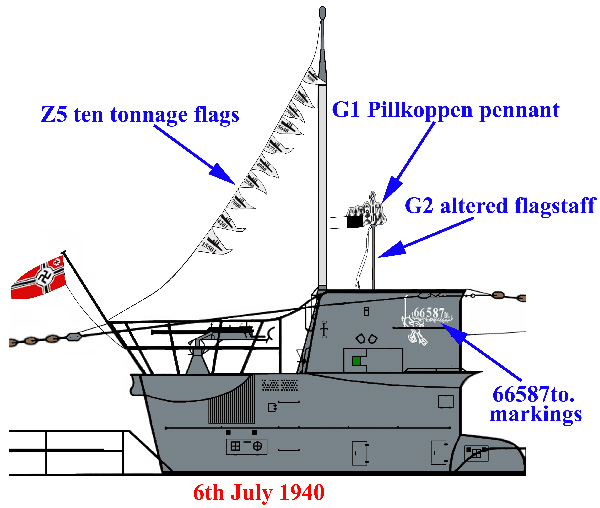You are viewing the archived version of the site.
Go to modelshipwrights.com for the current dynamic site!
Go to modelshipwrights.com for the current dynamic site!
1⁄35U 47 Modifications & Colours
April/May 1940
U 47 was present in the Germaniawerft shipyards in Kiel from the 29th April 1940 until the 31st May 1940. The U-boat was dry-docked from the 9th May until the 15th May, and a test run was completed in Kiel harbour on the 30th May. The starboard diesel had broken down during the fifth patrol, on the 16th April, so it was repaired (F1) when U 47 returned to port. The crack in starboard diving tank IV (F2), sustained on the 9th April due to numerous depth charges, was also fixed. U 47 became grounded and stuck on two occasions during the fifth patrol – on the 14th April and early on the 16th April, off Norway. What damage, if any, occurred due to these groundings is unclear; perhaps the only consequence was that the anti-fouling paint and undercoat were scraped off in parts of the hull.
At some stage both diesel exhaust outlets were modified from being round in shape (along the aft drainage holes) to being oval in shape (above the level of the aft drainage holes) (F3). This may have occurred during this refit or the previous one.

Above is a comparison which shows how the diesel exhaust outlets were modified.
6th July 1940
When U 47 returned to Kiel from the very successful sixth patrol on the 6th July 1940, the boat was very heavily weathered, with patches of the undercoat showing through in places. When U-boats were subjected to heavy weathering, their top layer of paint would peel off in patches. The older paint, or even the red or grey primer, that was beneath the top layer would be revealed. The first area for this to occur in was often the bow. The older bull had been painted over with a patch of Dunkelgrau 51 paint. Then a fresh version of the snorting bull was added on top of the patch.
Once the crew had the opportunity to shave and wash after U 47’s return, the commander’s flagstaff was held in place on the starboard bulwark. The photographs taken at this time (6th July 1940 or shortly thereafter) show the Pillkoppen pennant (G1) for the first time. This pennant was in place on the top of a new or altered commander’s flagstaff (G2). The new flagstaff did not have the attachment near the bottom which could be used to tie down the commissioning pennant, and prevent it flapping in the wind. The addition of the Pillkoppen pennant and the new or altered flagstaff occurred at some stage prior to July 1940, though the exact time period is impossible to determine. For more details of the Pillkoppen pennant see the “snorting bull” future Feature.

U 47 had ten victory pennant flags (erfolgswimpeln) flying from the attack periscope on the 6th July 1940.

The Pillkoppen pennant is to the left of Prien’s outstretched arm. The two separate attachment points for the jumping wires are obvious in this photo. In 1938 and 1939, the jumping wires had been attached to the tower at only one point per side. Less obvious is the small fairlead at the trailing edge of the tower bulwark.
July/August 1940
U 47’s next refit took place in the Germaniawerft shipyards in Kiel between the 8th July 1940 and the 20th August 1940. The period between the 26th July and the 8th August were spend in dry-dock, and a test run was completed in Kiel harbour on the 17th August. The most notable addition during this refit was the fitting of air trunks (H1). In original VIIs (also known as VIIAs) and VIIBs such as U 47, the supply of air to the diesel engines was poor. The main trunk providing air to the diesels was routed forward under the rear deckcasing and up inside the after end of the tower. Ventilation holes to let air into the intake trunk were located on the after sides of the tower wall, primarily on the starboard side, and these were susceptible to interruption in high seas. To rectify this problem, during this refit large external trunks were built up both sides of the tower, starting under the wintergarten platform and extending up the after edge of the conning tower bulwarks.
Copyright ©2021 by Dougie Martindale. _OPINIONS Model Shipwrights, KitMaker Network, or Silver Star Enterrpises. Images also by copyright holder unless otherwise noted. Opinions expressed are those of the author(s) and not necessarily those of Model Shipwrights. All rights reserved. Originally published on: 2006-02-24 00:00:00. Unique Reads: 21696








